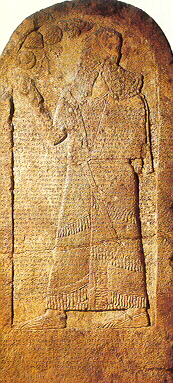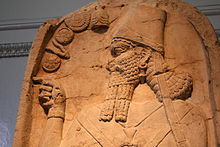
Shalmaneser III was king of the Neo-Assyrian Empire from the death of his father Ashurnasirpal II in 859 BC to his own death in 824 BC.

Hormuzd Rassam was an Assyriologist and author. He is known for making a number of important archaeological discoveries from 1877 to 1882, including the clay tablets that contained the Epic of Gilgamesh, the world's oldest notable literature. He is widely believed to be the first-known Middle Eastern and Assyrian archaeologist from the Ottoman empire. He emigrated to the United Kingdom, where he was naturalized as a British citizen, settling in Brighton. He represented the government as a diplomat, helping to free British diplomats from captivity in Ethiopia.

Nimrud is an ancient Assyrian city located in Iraq, 30 kilometres (20 mi) south of the city of Mosul, and 5 kilometres (3 mi) south of the village of Selamiyah, in the Nineveh Plains in Upper Mesopotamia. It was a major Assyrian city between approximately 1350 BC and 610 BC. The city is located in a strategic position 10 kilometres (6 mi) north of the point that the river Tigris meets its tributary the Great Zab. The city covered an area of 360 hectares. The ruins of the city were found within one kilometre (1,100 yd) of the modern-day Assyrian village of Noomanea in Nineveh Governorate, Iraq.

The Black Obelisk of Shalmaneser III is a black limestone Neo-Assyrian sculpture with many scenes in bas-relief and inscriptions. It comes from Nimrud, in northern Iraq, and commemorates the deeds of King Shalmaneser III. It is on display at the British Museum in London, and several other museums have cast replicas.

Ashur-nasir-pal II was king of Assyria from 883 to 859 BC. Ashurnasirpal II succeeded his father, Tukulti-Ninurta II. His son and successor was Shalmaneser III and his queen was Mullissu-mukannišat-Ninua.

Balawat is an archaeological site of the ancient Assyrian city of Imgur-Enlil, and modern village in Nineveh Province (Iraq). It lies 25 kilometres (16 mi) southeast from the city of Mosul and 4 kilometres (2.5 mi) to the south of the modern Assyrian town of Bakhdida.

Mead Art Museum houses the fine art collection of Amherst College in Amherst, Massachusetts. Opened in 1949, the building is named after architect William Rutherford Mead, of the prestigious architectural firm McKim, Mead & White. His wife, Olga Kilyeni Mead, left her entire estate to Amherst College. The museum, a member of Museums10, is free and open to the public.

Marduk-zâkir-šumi, inscribed mdAMAR.UTU-za-kir-MU in a reconstruction of two kinglists, “Marduk pronounced the name,” was a king of Babylon from 855 to 819 BC during the mixed dynastic period referred to in antiquity as the dynasty of E. He was a contemporary of the Assyrian kings, Salmānu-ašarēdu III) and Šamši-Adad V with whom he was allied.

The Department of the Middle East, numbering some 330,000 works, forms a significant part of the collections of the British Museum, and the world's largest collection of Mesopotamian antiquities outside Iraq. The collections represent the civilisations of the ancient Near East and its adjacent areas.

The Neo-Assyrian Empire was the fourth and penultimate stage of ancient Assyrian history. Beginning with the accession of Adad-nirari II in 911 BC, the Neo-Assyrian Empire grew to dominate the ancient Near East throughout much of the 8th and 7th centuries BC, becoming the largest empire in history up to that point. Because of its geopolitical dominance and ideology based in world domination, the Neo-Assyrian Empire is by many researchers regarded to have been the first world empire in history. It influenced other empires of the ancient world culturally, governmentally, and militarily, including the Babylonians, the Achaemenids, and the Seleucids. At its height, the empire was the strongest military power in the world and ruled over all of Mesopotamia, the Levant and Egypt, as well as parts of Anatolia, Arabia and modern-day Iran and Armenia.
The Old Assyrian period was the second stage of Assyrian history, covering the history of the city of Assur from its rise as an independent city-state under Puzur-Ashur I c. 2025 BC to the foundation of a larger Assyrian territorial state after the accession of Ashur-uballit I c. 1363 BC, which marks the beginning of the succeeding Middle Assyrian period. The Old Assyrian period is marked by the earliest known evidence of the development of a distinct Assyrian culture, separate from that of southern Mesopotamia and was a geopolitically turbulent time when Assur several times fell under the control or suzerainty of foreign kingdoms and empires. The period is also marked with the emergence of a distinct Assyrian dialect of the Akkadian language, a native Assyrian calendar and Assur for a time becoming a prominent site for international trade.


The Balawat Gates are three sets of decorated bronze bands that had adorned the main doors of several buildings at Balawat, dating to the reigns of Ashurnasirpal II and Shalmaneser III. Their extensive use of narrative art depicting the exploits of Assyrian kings has cemented their position as some of the most important surviving works of art of the Neo-Assyrian Empire, comparable to the extensive Assyrian palace reliefs. When the Neo-Assyrian Empire fell in 614-612 BC, Balawat was destroyed. The wooden elements of the gates decomposed, leaving only the bronze bands. The remains of two sets of gates can be found in the British Museum's collection, those from the Temple of Mamu are housed in the Mosul Museum. Small sections of the Shalmaneser bronze door bands are also in the Louvre Museum at the Walters Art Museum in Baltimore and in the Istanbul Archaeology Museums.

The Statue of Ashurnasirpal II is a rare example of Assyrian sculpture in the round that was found in the mid nineteenth century at the ancient site of Kalhu by the famous archaeologist Austen Henry Layard. Dating from 883–859 BC, the statue has long been admired for its flawless condition and the high quality of its craftsmanship. It has been part of the British Museum's collection since 1851.

The White Obelisk is a large stone monolith found at the ancient Assyrian settlement of Nineveh, northern Iraq. Excavated by the British archaeologist Hormuzd Rassam in 1853, it is one of only two intact obelisks to survive from the Assyrian empire, the other being the Black Obelisk of Shalmaneser III. Both are now preserved in the British Museum. The White Obelisk dates to the beginning of the Neo-Assyrian Empire and has been variously ascribed to the reigns of Ashurnasirpal I, Tiglath-Pileser II or Ashurnasirpal II.

The Stela of Ashurnasirpal II is an enormous Assyrian monolith that was erected during the reign of Ashurnasirpal II. The stela was discovered in the mid nineteenth century at the ancient site of Kalhu by the famous British archaeologist Austen Henry Layard. Dated to between 883-859 BC, the sculpture is now part of the British Museum's collection.

Assyrian sculpture is the sculpture of the ancient Assyrian states, especially the Neo-Assyrian Empire of 911 to 612 BC, which was centered around the city of Assur in Mesopotamia which at its height, ruled over all of Mesopotamia, the Levant and Egypt, as well as portions of Anatolia, Arabia and modern-day Iran and Armenia. It forms a phase of the art of Mesopotamia, differing in particular because of its much greater use of stone and gypsum alabaster for large sculpture.

The royal Lion Hunt of Ashurbanipal is shown on a famous group of Assyrian palace reliefs from the North Palace of Nineveh that are now displayed in room 10a of the British Museum. They are widely regarded as "the supreme masterpieces of Assyrian art". They show a formalized ritual "hunt" by King Ashurbanipal in an arena, where captured Asian lions were released from cages for the king to slaughter with arrows, spears, or his sword. They were made about 645–635 BC, and originally formed different sequences placed around the palace. They would probably originally have been painted, and formed part of a brightly coloured overall decor.

Mullissu-mukannishat-Ninua was a queen of the Neo-Assyrian Empire as the primary consort of Ashurnasirpal II. She was probably also the mother of his son and successor Shalmaneser III. Mullissu-mukannishat-Ninua is only known from her tomb, discovered in Nimrud in 1989. She was the daughter of the "great cupbearer" Ashur-nirka-da’’inni and as such probably belonged to the Assyrian aristocracy before she became queen.



















